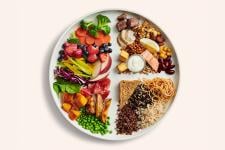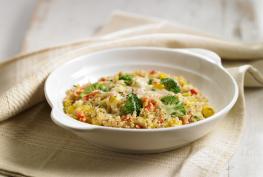Whole grain foods are an important part of healthy eating.
On this page
Whole grain foods are good for you
Whole grain foods have important nutrients such as:
- fibre
- vitamins
- minerals
Whole grain foods are a healthier choice than refined grains because whole grain foods include all parts of the grain. Refined grains have some parts of the grain removed during processing.
Whole grain foods have more fibre than refined grains. Eating foods higher in fibre can help lower your risk of:
- stroke
- colon cancer
- heart disease
- type 2 diabetes
Choosing and preparing healthy whole grain foods
Enjoy a variety of whole grain foods every day, such as:
- quinoa
- whole grain pasta
- whole grain bread
- whole oats or oatmeal
- whole grain brown or wild rice
Some grain foods can have a lot of added sodium, sugars or saturated fat. These include foods like:
- bakery products
- sugary breakfast cereals
- pre-packaged frozen pasta dishes
Use food labels to choose foods that have less sodium, sugars or saturated fat.
Make sure your choices are actually whole grain
Whole wheat and multi-grain foods may not be whole grain. Some foods may look like they are whole grain because of their colour, but they may not be.
Read the ingredient list and choose foods that have the words “whole grain” followed by the name of the grain as one of the first ingredients like:
- whole grain oats
- whole grain wheat
Whole wheat foods are not whole grain, but can still be a healthy choice as they contain fibre.
Fibre
Use the nutrition facts table to compare the amount of fibre between products. Look at the % daily value to choose those with more fibre.
Preparing whole grain foods
Whole grain foods can be tasty and nutritious without adding highly processed sauces and spreads. Enjoy the true taste of whole grain foods.
Try healthier ways to prepare your whole grain foods by:
- leaving out or reducing the amount of salt added during preparation
- limiting the amount of sauce or spreads you add
- adding vegetables, vegetable oils, spices and herbs to enhance flavours
Snack ideas
Whole grain foods make quick and healthy snacks. There are lots of choices and many ways to enjoy them. Try:
- whole grain cereals
- whole grain crackers
- whole grain baked pita “chips”
How to include whole grain foods
Here are some easy ways to eat more whole grain foods:
- Try a new whole grain each week:
- farro
- freekeh
- amaranth
- buckwheat
- Mix different whole grain cereals in your bowl and enjoy with lower fat white milk or unsweetened plant-based beverages.
- Start your day with a bowl of oatmeal, whole grain cereal or whole grain toast.
- Keep a variety of whole grain foods in your pantry. Try:
- oats
- quinoa
- brown rice
- whole grain pasta
- whole grain bread
To increase the amount of whole grain foods in your recipes, try adding:
- barley, bulgur and quinoa to soups, salads and stir-fries
- brown or wild rice to white rice for more fibre and a nutty flavour
Make a healthy choice
What you eat on a regular basis matters for your health.
- Choose foods that have little to no added sodium, sugars or saturated fat.
- Compare the nutrition facts table on foods to choose products that are lower in sodium, sugars or saturated fat.
- Date modified:


